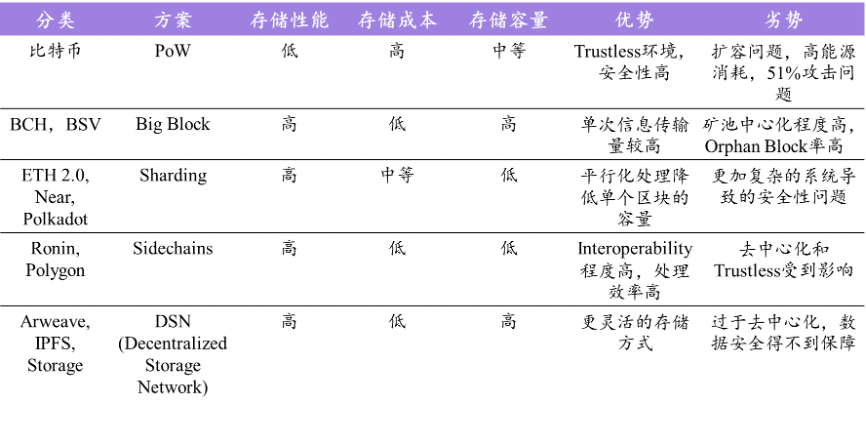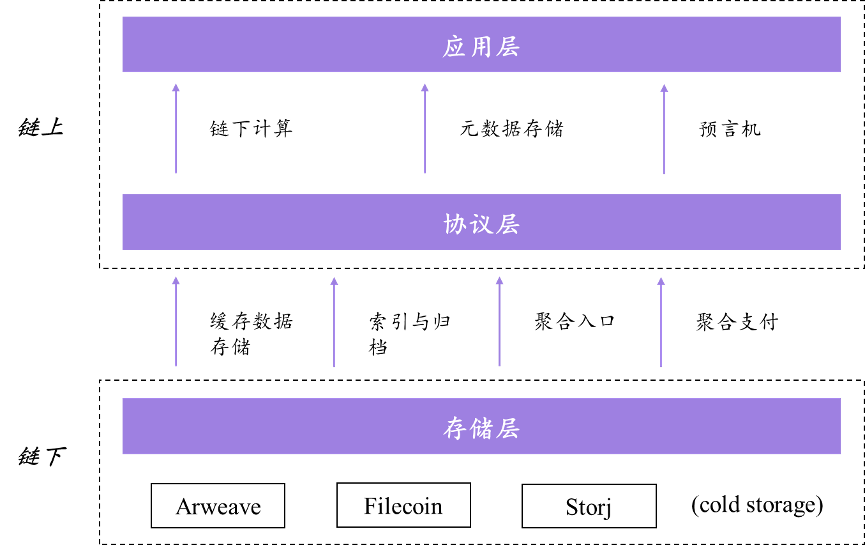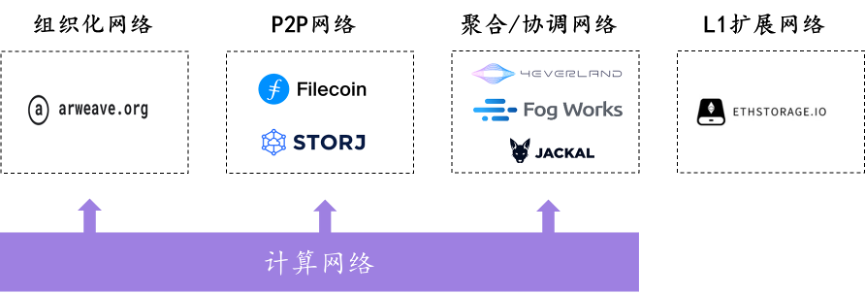TL; DR
Separating non-core data from the main chain and storing it in a DSN (Decentralized Storage Network) has become a mainstream solution for capacity expansion, interoperability and privacy protection.
Filecoin has great advantages in miner network and storage cost, but Arweave's permanent storage can provide a more reliable solution for NFT or social applications.
L1 extended storage network can provide a new solution with higher interoperability than DSN, but still needs a time verification mode.
secondary title
1. The development history of decentralized storage
The data storage sector has always been the cornerstone of the development of the technology industry and a key area of focus. Since the provision of centralized cloud storage services based on Amazon, Microsoft, Alibaba, etc., the cloud storage market has basically formed a market size of more than 100 billion US dollars (2021) and the head effect is obvious (Amazon 40%, Microsoft 22%, Alibaba Cloud 10%, data source Gartner). With the outbreak of Web3, a group of decentralized storage providers began to meet the needs that the traditional cloud storage market could not meet. Although most dApps are still deployed on AWS at present, and more than 50% of Ethereum nodes are running on AWS before the merge[1], but the Web3 project has gradually discovered that the backend and metadata and decentralized storage The importance and inevitability of connection. According to the definition of Ethereum.org, decentralized storage is a data sharing system composed of a p2p network, each operator owns a part of the overall data and can be restored through algorithms [2]. Although decentralized storage can solve many problems, such as data privacy protection, anti-censorship, etc., the current decentralized system is immature and there are many problems that need to be solved urgently. After continuous attempts of storage solutions on the (main) chain, DSN (Decentralized Storage Network) is the current mainstream solution. This solution can maximize the storage capacity to nearly unlimited, and has great impact on data security and privacy. Guaranteed.
image description

image descriptionhttps://zhuanlan.zhihu.com/p/48078642
source:Puzzle Ventures
image description

source:Puzzle Ventures
secondary title
2. Development Status of Decentralized Storage: Classification and Scale
image description

source:Puzzle Ventures
In addition, there are computing networks and coordination middleware built on the underlying storage network or independent, which are also supplementary parts of the decentralized storage ecology, but mainly ecological dApps, which are not discussed in this article.
From the perspective of development scale, Filecoin is far ahead in terms of revenue, FDV and market share, and user storage usage is still increasing. However, a quarterly revenue of more than three million US dollars is not much in the Web2 or Web3 field, and it is still in the case of an almost monopoly. Therefore, the entire decentralized storage track still has a lot of room for development.
image description

source:Messari, Web3 Index, CoinGecko
secondary title
3. Mainstream solutions: Comparison between Filecoin and Arweave
1. Functionality
source:

source:Fundamental Labs
Judging from the latest technological development process, Filecoin version 17 "Shark" mainly establishes the programmability of the storage protocol, that is, adds an interactive layer of smart contracts to the storage layer, and plans to launch the FEVM system in February next year. The availability and activity of data on Filecoin will be improved, and it can support more diversified interoperability, which is also the flexibility advantage of Filecoin compared to Arweave. However, Arweave still focuses on data security, node incentive stability (endowment) and storage entrance, and continues to "recharge belief" in the concept of permanent storage. Therefore, although it is difficult to say which solution is more advantageous, in any case, these two decentralized storage protocols have developed relatively complete functions to meet the basic needs of decentralized storage.
2. Fees
Similarly, it is difficult to compare Filecoin and Arweave intuitively in terms of fees. This article aims to form a certain perception of the fees of the two in as reasonable a way as possible. In order to form data comparability, this article uses the price of the same storage size within a storage time of 200 years as the comparison object (Arweave generally believes that it can support storage for 200 years).
source:

source:Amazon.com, Arweavefees.com, File.app, Filfox.info
As can be seen from Table 3, the price of the most basic AWS S3 Standard package is about $0.023 per GB per month, and the storage for 200 years requires $55.2 per GB, while the Glacier Deep Archive solution, which is relatively more suitable for long-term cold storage, can That keeps the price down to $2.38 per GB, but there is a limit to the number of archives per year. However, Arweave will have different prices as the price of AR token fluctuates. The price in December 2022 is $1.42 per GB, which means that the storage cost of about 5 years can be equal to the storage cost of S3 standard. On the other hand, the price calculation of Filecoin is more complicated, because the prices given by different miners are different, and the price of FIL token, storage time and frequency of data calls will all affect the price. But in any case, the storage cost of Filecoin is several orders of magnitude cheaper than that of Arweave and S3, and it can be considered almost zero-cost storage.
3. Ecology
The ecology of decentralized storage includes miners/nodes and ecological dApps.
image description

Source: Filscan.io, MessariFilecoin
secondary title
4. New solution: converged network and L1 expanded network
1. Converged Network
The concept of an aggregated network actually existed as early as the beginning of Filecoin's launch, such as early projects such as Coldstack. However, Coldstack has not been a huge success, mainly because pure, Uber-like aggregators don't really improve storage efficiency and provide no further value beyond that. The aggregation network of the storage protocol can indeed solve the pain points of the user's storage efficiency and cost, but there are many ways to do it. First of all, these aggregated networks have to do better than Filecoin and Arweave's own gateways to gain market recognition. As Filecoin develops towards computing on the FVM chain, it is likely to squeeze out a number of aggregation networks built on top of Filecoin to provide additional computation capabilities. Secondly, different aggregation protocols should solve the problem that Filecoin or Arweave itself is difficult to implement, instead of making a unified aggregation traffic entrance (at least not the early entry point), because the unified traffic entrance will eventually be controlled by Filecoin and Arweave themselves. control.
Jackal is an aggregator solution built on top of Filecoin and focused on improving data privacy and security. It provides a set of further AES-256 encryption schemes for stored files, and manages and charges through the L1 chain of PoS consensus established by Cosmos, which is equivalent to establishing a layer of private cloud storage protocol on top of Filecoin. At the same time, Jackal will also use its Proof-of-Persistence algorithm to provide 3 times the number of file copies and optimize storage prices. Redundancy and cost are not the core issues of decentralized storage, but the improvement of data privacy and security is difficult for Filecoin itself to achieve in a short period of time. 4 EVERLAND is another cloud computing platform that aggregates Filecoin, Arweave and Dfinity as the underlying storage layer. connection layer between. From the current point of view, Web hosting and Bucket are its two main products. Hosting can complete front-end hosting under the acceleration of more than 200 gateways around the world in 4 EVERLAND, while Bucket is an aggregation gateway. These two products have greatly improved the actual usage of decentralized storage in terms of user-friendliness, and solved optimization problems at the detail level such as multi-currency payment and data panels.
2. L1 storage expansion network
secondary title
5. Possibility of future development
In general, the development of Filecoin and Arweave has become a representative project of decentralized storage, and it also represents the basic completion of the 0 to 1 process of decentralized storage. In terms of development concept, splitting non-chain core data into the storage layer has become the main means of Ethereum expansion. At the same time, the storage aggregation network and L1 extended network are supplemented and extended, which can meet the specific needs of users more efficiently and at low cost. However, there are still many problems to be solved in the basic DSN network: fewer ecological applications, storage and computing Issues such as separation and difficult Web2 onboarding have hindered DSN from moving towards the next wave of growth. In the future, this article judges that the following types of projects may become the next wave of growth engines:
1. DSN aggregator: Aggregation portals built on different/same DSN networks, and provide cost-optimized options, unified token payment, data availability/calling services, etc. to improve user-friendliness. Similar projects: Lighthouse, 4 EVERLAND
2. off-chain computation: Although Filecoin already has a decentralized computing layout on the chain, pure on-chain computing cannot meet more complex computing requirements. A comprehensive solution that combines on-chain data and off-chain computing can increase the value of data and expand use cases by completing more complex calculations. Similar projects: KwilDB, Tableland
3.L1 storage expansion network: The advantage of L1 storage and computing power expansion is that it can directly generate deep connections with the L1 ecosystem. Even if it meets projects with large data storage requirements such as social and gaming, it can also achieve rapid and large-scale integration after obtaining official approval. Similar project: EthStorage
4. Third-party data security network: To protect the data stored in the existing DSN, to review, back up and block hacker attacks on storage nodes, and to provide relevant compensation insurance schemes. Similar items: Jackal
Original link: https://mp.weixin.qq.com/s/KDpI 6 OTMCpDsOgDUDCg 6 sg
By Jason, Puzzle Ventures